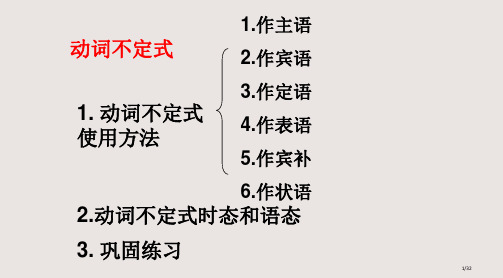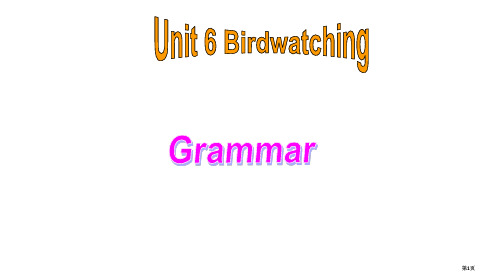动词不定式做目的状语专项突破优秀课件
合集下载
动词不定式的用法归纳PPT课件

连用,在句中起名词作用,可充当主语、表语、宾语等 。
ØHe didn’t know what to say.
ØHow to solve the problem is very important.
ØMy question is when to start.
注意:•在与why连用时,只用于why或why not开头的简
(subject) 3. My ambition is to work in the computer
industry when I grow up. (predicative)
第17页,共52页。
4. I don’t have time to sit around feeling sorry for myself. (attribute)
第2页,共52页。
1. 作主语
2. 作宾语 3. 作宾语补足语 4. 作定语
5. 作状语
6. 作表语 7. 作独立成分
8. 与疑问词等连用
第3页,共52页。
1 不定式作主语 (subject)
谓语动词用单数形式。 To see is to believe. To keep smiling is healthy for you. It’s important to learn English well.
He is looking for a room ptola_y__w_i_t_h______ (live).
He needs a friend to __________ (play).
choose from
There are three pairs ofБайду номын сангаасshoes for you to _________ (choose).
ØHe didn’t know what to say.
ØHow to solve the problem is very important.
ØMy question is when to start.
注意:•在与why连用时,只用于why或why not开头的简
(subject) 3. My ambition is to work in the computer
industry when I grow up. (predicative)
第17页,共52页。
4. I don’t have time to sit around feeling sorry for myself. (attribute)
第2页,共52页。
1. 作主语
2. 作宾语 3. 作宾语补足语 4. 作定语
5. 作状语
6. 作表语 7. 作独立成分
8. 与疑问词等连用
第3页,共52页。
1 不定式作主语 (subject)
谓语动词用单数形式。 To see is to believe. To keep smiling is healthy for you. It’s important to learn English well.
He is looking for a room ptola_y__w_i_t_h______ (live).
He needs a friend to __________ (play).
choose from
There are three pairs ofБайду номын сангаасshoes for you to _________ (choose).
公开课课件动词不定式的用法

05
动词不定式与其他非谓语动词比较
与动名词比较
动词不定式和动名词在句子中都可以充当主语、宾语等成分,但它们的意义和用法 有所不同。
动词不定式表示具体的、一次性的动作,而动名词则表示抽象的、习பைடு நூலகம்性的动作。
在某些情况下,动词不定式和动名词可以互换使用,但表达的含义可能有所不同。
与现在分词比较
动词不定式和现在分词都可以表示主 动的动作,但它们的时态和语态有所 不同。
在某些情况下,动词不定式和现在分 词可以互换使用,但需要根据具体语 境来判断。
动词不定式不受时态限制,可以表示 过去、现在或将来的动作,而现在分 词则通常表示正在进行的动作。
与过去分词比较
动词不定式和过去分词都可以表示被动的动作,但它们的用法和意义有 所不同。
动词不定式表示被动的动作时,需要使用助动词be的适当形式,而过去 分词则可以直接表示被动的动作。
03
动词不定式在句子中作用
作主语
01
动词不定式作主语时,谓语动词 用单数形式。
02
常用it作形式主语,把真正的主语 动词不定式置于句后。
作宾语
能够接动词不定式作宾语的有ask, agree, beg, decide, determine等 。
动词不定式与名词等构成复合宾语时 ,通常要用it作形式宾语,而把真正的 宾语动词不定式置于句后。
择合适的动词形式。例如,正确的表达是 “I enjoy listening to music”,而不是
“I enjoy to listen to music”。
逻辑主语问题
要点一
不定式逻辑主语与句子主语不一 致
动词不定式的逻辑主语应与句子主语保持一致。例如,正 确的表达是“It is important for you to study hard”, 而不是“It is important for him to study hard”。
公开课动词不定式的用法课件省公开课金奖全国赛课一等奖微课获奖PPT课件

8/32
动词不定式作宾语应注意问题 2. 假如不定式作宾语而后面又有一个 宾语补足语,这时要用it作形式宾语 而把这个动词不定式放到补语后。 I feel it my duty to help you. I once thought it impossible for us to finish the job in such a limited time.
What I would suggest is to start work at once.
12/32
注:在一些句型中,当主语部分有动作 动词do 时,作表语不定式能够省略符号 “to”,如:
All we have to do is push the button.
The only thing I can do now is go on by myself.
4/32
2. 动词不定式作宾语 动词不定式作宾语惯用于以下动词后:
want, agree, decide, manage, wish, hope, ask, like, love , choose, promise, continue, plan, learn, expect, offer, prepare, refuse, pretend, attempt, intend, threaten, seek, hesitate, long, desire, fail等 等。
3/32
复合结构: 1)for sb. to do sth 2) (It is +性格adj+)of sb. to do sth 性格adj:nice, kind, cruel, thoughtful, careful, careless… It is very important for us to learn English. It is difficult for him to finish the task in such a short time. It is very nice of you to help me.
动词不定式作宾语应注意问题 2. 假如不定式作宾语而后面又有一个 宾语补足语,这时要用it作形式宾语 而把这个动词不定式放到补语后。 I feel it my duty to help you. I once thought it impossible for us to finish the job in such a limited time.
What I would suggest is to start work at once.
12/32
注:在一些句型中,当主语部分有动作 动词do 时,作表语不定式能够省略符号 “to”,如:
All we have to do is push the button.
The only thing I can do now is go on by myself.
4/32
2. 动词不定式作宾语 动词不定式作宾语惯用于以下动词后:
want, agree, decide, manage, wish, hope, ask, like, love , choose, promise, continue, plan, learn, expect, offer, prepare, refuse, pretend, attempt, intend, threaten, seek, hesitate, long, desire, fail等 等。
3/32
复合结构: 1)for sb. to do sth 2) (It is +性格adj+)of sb. to do sth 性格adj:nice, kind, cruel, thoughtful, careful, careless… It is very important for us to learn English. It is difficult for him to finish the task in such a short time. It is very nice of you to help me.
动词不定式的用法表目的课件公开课一等奖优质课大赛微课获奖课件

第12页
常跟不带to动词不定式 作宾语补足语动词有:感官动词hear, feel, see, watch, notice等;使役动词let, make和have。
make or let + object + infinitive without to e.g. Max tells funny jokes and often
1. I often go to the market ___to__w_a_tc_h__(watch ) the flowers. 2.We should make laws __to__p_re_v_e_n_t__( prevent) people
killing bears. 3. Jim will go to the park ____to__fl_y____(fly) kites. 4.She will go to the supermarket _t_o_b_u_y______(buy) some
there in time. In order to get there in time, they started early.
为了及时赶到那里,他们很早就出发了。
第7页
Amy is thinking about the things people do in Zhalong Nature Reserve. Match the first parts of the sentences on the left with the second parts on the right. Write the correct letters in the blanks.
birds.
3.Many people take a camera __t_o_____(take) photos. 4.Many people take a camera intoarkdeer __to_____ (take)
常跟不带to动词不定式 作宾语补足语动词有:感官动词hear, feel, see, watch, notice等;使役动词let, make和have。
make or let + object + infinitive without to e.g. Max tells funny jokes and often
1. I often go to the market ___to__w_a_tc_h__(watch ) the flowers. 2.We should make laws __to__p_re_v_e_n_t__( prevent) people
killing bears. 3. Jim will go to the park ____to__fl_y____(fly) kites. 4.She will go to the supermarket _t_o_b_u_y______(buy) some
there in time. In order to get there in time, they started early.
为了及时赶到那里,他们很早就出发了。
第7页
Amy is thinking about the things people do in Zhalong Nature Reserve. Match the first parts of the sentences on the left with the second parts on the right. Write the correct letters in the blanks.
birds.
3.Many people take a camera __t_o_____(take) photos. 4.Many people take a camera intoarkdeer __to_____ (take)
动词不定式(12张PPT)初中英语专项复习课件

She wants to play the piano. 她想弹钢琴。
Jim told me not to wake up Kate. 吉姆告诉我不要叫醒凯特。
语法透视
考点大观 易错辨析 通关训练
动词不定式的用法
2. 不带to的不定式结构。 (1) 在固定词组had better之后。注意:had better
—Mary is very generous. —Yes, she gave away all her money she owned
____ people in need. A. to help B. to helping C. helped D. helping
【解析】本句话意为“玛丽真是太慷慨了。是的, 她把她所有的钱都捐给了缺钱的人们”。表目的 用动词不定式,所以答案选A。
动词不定式的结构: to + 动词原形
语法透视
动词不定式的用法
考点大观 易错辨析 通关训练
1. 省to的不定式结构 (1) 能 直 接 跟 带 to 的 不 定 式 结 构 的 动 词 主 要 有 :
want, ask, tell, hope, learn, try, decide, forget, remember, like, love, stop等。 (2) 动词不定式的否定形式是在不定式前直接加not ,即not to do sth。
语法透视
动词不定式的用法
考点大观
3. 动词不定式作主语。动词不定式作主语可以放在 后面,而用it作形式主语放在原主语的位置上。
易错辨析 通关训练
To master a language is not an easy thing. 掌握一门语言不是一件容易的事情。
初中动词不定式完整ppt课件

但有的动词(如:need, want, require等)后面接动名词或动 词不定式作宾语均可。
在It + be + 形容词(easy, difficult, expensive等) + 不 定式句型中,动词不定式常用it 作形式宾语,而将真正的宾语 放到句子后面。
作定语
动词不定式作定语时,要放在被修饰的名词之后,表示与这个名词有逻辑上的动宾 关系,即不定式动词可以修饰的名词应是它的表语或宾语。
误用动词不定式的时态和语态
动词不定式的时态和语态需要根据句子的语境和上下文进行判断,但在 实际使用中,学生往往容易忽略这一点,导致时态和语态的错误使用。
注意事项
注意动词不定式的正确性
在使用动词不定式时,要确保其形式 的正确性,包括时态、语态、逻辑主 语等方面。
注意上下文语境
多练习、多积累
掌握动词不定式的用法需要大量的练 习和积累,因此学生应该多做相关练 习,多阅读相关材料,以便更好地掌 握这一语法点。
例如
They were watching TV at this time yesterday.(昨天这 个时候他们正在看电视)
语态的转换
1 2
主动语态 表示主语是动作的执行者
被动语态 表示主语是动作的承受者
3
动词不定式的语态转换
将主动语态的不定式改为被动语态的不定式,一 般在不定式前加to be,并将不定式的逻辑主语 作为被动语态的主语
04
动词不定式的省略和倒装
省略情况
当动词不定式在句子中作宾语补足语,表示的是一次性 的具体动作,且句子的主语和不定式的逻辑主语一致时, 可以省略to。
当动词不定式中的动词是be、have、助动词或情态动 词时,可以省略to。
语法不定式做状语课件

举例
He worked hard to get promoted.(他努力工作以获得 晋升。)
05
练习与巩固
填空练习
总结词
提高应用能力
详细描述
通过填空练习,让学生更好地理 解和掌握不定式做状语的用法, 提高他们在语境中应用不定式做 状语的能力。
选择练习
总结词
辨析不同用法
详细描述
通过选择练习,让学生学会区分和辨 析不定式做状语在不同语境中的不同 用法,加深对语法的理解。
不定式做条件状语
总结词
表示假设条件
详细描述
不定式做条件状语时,常用于表示假设条件,说明在某种条件下某事会发生。例 如,“如果他知道答案,他会举手”。
不定式做原因状语
总结词:表示原因
详细描述:不定式做原因状语时,用来解释某个动作或状态发生的原因。例如, “他高兴得跳了起来”。
不定式做伴随状语
总结词
不定式的否定形式
否定形式
在不定式前面加上否定词not或never。
常见否定词
not、never、no、none等。
举例
I decided not to go to the party.(我决定不去 参加派对。)
不定式的时态和语态
01
02
03
时态
不定式可以表示将来、现 在或过去的时间。
语态
不定式可以表示主动或被 动。
翻译练习
总结词
跨语言应用
详细描述
通过翻译练习,让学生将不定式做状语的用法应用到不同语 言中,提高他们的跨语言应用能力。
THANKS FOR WATCHING
感谢您的观看
表示伴随的动作或状态
详细描述
不定式做伴随状语时,用来描述某个动作发生时伴随的其他动作或状态。例如,“他进来时,带着微笑”。
He worked hard to get promoted.(他努力工作以获得 晋升。)
05
练习与巩固
填空练习
总结词
提高应用能力
详细描述
通过填空练习,让学生更好地理 解和掌握不定式做状语的用法, 提高他们在语境中应用不定式做 状语的能力。
选择练习
总结词
辨析不同用法
详细描述
通过选择练习,让学生学会区分和辨 析不定式做状语在不同语境中的不同 用法,加深对语法的理解。
不定式做条件状语
总结词
表示假设条件
详细描述
不定式做条件状语时,常用于表示假设条件,说明在某种条件下某事会发生。例 如,“如果他知道答案,他会举手”。
不定式做原因状语
总结词:表示原因
详细描述:不定式做原因状语时,用来解释某个动作或状态发生的原因。例如, “他高兴得跳了起来”。
不定式做伴随状语
总结词
不定式的否定形式
否定形式
在不定式前面加上否定词not或never。
常见否定词
not、never、no、none等。
举例
I decided not to go to the party.(我决定不去 参加派对。)
不定式的时态和语态
01
02
03
时态
不定式可以表示将来、现 在或过去的时间。
语态
不定式可以表示主动或被 动。
翻译练习
总结词
跨语言应用
详细描述
通过翻译练习,让学生将不定式做状语的用法应用到不同语 言中,提高他们的跨语言应用能力。
THANKS FOR WATCHING
感谢您的观看
表示伴随的动作或状态
详细描述
不定式做伴随状语时,用来描述某个动作发生时伴随的其他动作或状态。例如,“他进来时,带着微笑”。
动词不定式作状语PPT课件

I walked quietly so as not to disturb the baby.
-
4
4. 不定式作目的状语可转换为 so that / in order that 或 so ... that ... 引导的目的状语 从句。如:
He worked very hard to pass the exam.
5. She doesn’t go out with people who smoke i_n__o_rd_e_r__n_o_t _to__/_s_o_a_s_n_o_t__to__ start smoking again.
-
12
Complete these sentences with so or such (a).
2. A lot of people visit the centre i_n__o_rd_e_r_t_o_/_s_o_a_s__to__se_e__th_a_t__fa_m__o_u_s_s_t_a_tu__e__.
3. Drug users have to steal things _i_n_o_r_d_e_r_t_o_/ _s_o_a_s_t_o_p__a_y_f_o_r_d_r_u_g_s____.
3. The government put up the price of cigarettes __in__o_r_d_er__to__/_s_o_a_s_t_o____stop people buying them.
-
11
4. The police went to the house __i_n_o_r_d_e_r_t_o_/_s_o__a_s_to__arrest the drug dealer.
-
4
4. 不定式作目的状语可转换为 so that / in order that 或 so ... that ... 引导的目的状语 从句。如:
He worked very hard to pass the exam.
5. She doesn’t go out with people who smoke i_n__o_rd_e_r__n_o_t _to__/_s_o_a_s_n_o_t__to__ start smoking again.
-
12
Complete these sentences with so or such (a).
2. A lot of people visit the centre i_n__o_rd_e_r_t_o_/_s_o_a_s__to__se_e__th_a_t__fa_m__o_u_s_s_t_a_tu__e__.
3. Drug users have to steal things _i_n_o_r_d_e_r_t_o_/ _s_o_a_s_t_o_p__a_y_f_o_r_d_r_u_g_s____.
3. The government put up the price of cigarettes __in__o_r_d_er__to__/_s_o_a_s_t_o____stop people buying them.
-
11
4. The police went to the house __i_n_o_r_d_e_r_t_o_/_s_o__a_s_to__arrest the drug dealer.
《动词不定式》课件

动词不定式作定语时,表示目的、 原因等意义
动词不定式的时态和语态
第四章
时态形式及用法
一般式:不定式的一般形式为to do,表示动作的一般情况
进行式:不定式的进行式为to be doing,表示动作正在进行
完成式:不定式的完成式为to have done,表示动作已经完成 完成进行式:不定式的完成进行式为to have been doing,表示动作 已经完成且一直持续到现在
常见问题解析
第六章
易混淆点解析
不定式作宾语与动名词作宾语的混淆 不定式作定语与动名词作定语的混淆 不定式作主语与动名词作主语的混淆 不定式作表语与动名词作表语的混淆
常见错误解析
不定式作为宾语补足语时, 动词后面缺少必要的介词
不定式作为主语或宾语时, 动词后面缺少必要的介词
不定式作为状语时,动词后 面缺少必要的介词
不定式作为定语时,动词后 面缺少必要的介词
练习与巩固
第七章
单项选择题
动词不定式作宾语时,其逻辑主语必须是句子的主语。 A. 对 B. 错 答案:A. 对
A. 对 B. 错
动 答 案 :词A . 对 不 定 式 作 宾 语 补 足 语 时 , 其 逻 辑 主 语 必 须 是 句 子 的 宾语。 A. 对 B. 错 答案:B. 错
A. 对 B. 错 答案:B. 错
动词不定式作状语时,其逻辑主语必须是句子的主语。 A. 对 B. 错 答案:A. 对
A. 对 B. 错 答案:A. 对
动词不定式作定语时,其逻辑主语必须是句子的宾语。 A. 对 B. 错 答案:B. 错
A. 对 B. 错 答案:B. 错
完形填空题
题目:动词不定式完形填空 内容:提供多个含有动词不定式的句子,要求学生在句子中填写正确的动词不定式形式 目的:帮助学生掌握动词不定式的用法和形式,提高语言运用能力 难度:根据学生水平设置不同难度的题目,包括简单、中等和困难等级别
动词非谓语动词动词不定式做宾语宾语补足语目的状语PPT课件

比较: I saw her crossing the street. I saw her cross the street. she was seen to cross the street.
4. 用作状语:
I went there to see my teacher. (目的) She gets up early to catch the early bus e(v目er的y )
既可以跟不定式有可跟动名词的动词: like, love,hate,start,begin… (意义相同)
try to do /doing
(意义不同)
forget/remember to do/doing
can’t help to do /doing
stop to do/doing
need to do /doing
1.用作主语
动名词
Helping others makes us happy. 2.用作宾语
He often practices playing chess with others. practice,enjoy,finish,miss,mind,keep,stand, can’t help,avoid,consider,imagine can’t help,give up,be busy, end up,feel like, look forward to, pay attention to,stick to ….
I saw hΒιβλιοθήκη m __ the supermarket just now.
a. entered
b. entering
c√. enter
d. to enter
The girl who sold matches was found ___ the next
4. 用作状语:
I went there to see my teacher. (目的) She gets up early to catch the early bus e(v目er的y )
既可以跟不定式有可跟动名词的动词: like, love,hate,start,begin… (意义相同)
try to do /doing
(意义不同)
forget/remember to do/doing
can’t help to do /doing
stop to do/doing
need to do /doing
1.用作主语
动名词
Helping others makes us happy. 2.用作宾语
He often practices playing chess with others. practice,enjoy,finish,miss,mind,keep,stand, can’t help,avoid,consider,imagine can’t help,give up,be busy, end up,feel like, look forward to, pay attention to,stick to ….
I saw hΒιβλιοθήκη m __ the supermarket just now.
a. entered
b. entering
c√. enter
d. to enter
The girl who sold matches was found ___ the next
高考英语动词不定式精讲解课件(共34张PPT)

B. 做结果状语,常与副词only, enough 或too连用。 only to do “不料(却)……,结果(却)……", 表示 一个没有料到的结果
He studied hard only to fail the exam. The road is too dangerous to cross.
请告诉你的小孩不要在街上玩耍。
Please tell your child not to play in the street.
她检查名字为了不犯错误。
She checked the names so as not to make mistakes.
三、时态和语态
一般式 进行式 完成式
主动形式 to do
C. 不定式做原因状语, 一般用在句尾 I’m glad to see you. They are quite surprised to see the great changes taking place in the area.
(6). 做宾语补足语
A. 常带to的不定式做宾语补足语的动词有: ask,
allow, require, advise, permit, expect, get,
forbid, invite, persuade, urge, order, force, cause, encourage等
结构: ask / allow sb. to do sth./ sth. to be done
5. “Have you decided when _A____?” “Yes,
4. T__o_m__a_k_e_(make) things worse, my car was held up by the traffic accident.
He studied hard only to fail the exam. The road is too dangerous to cross.
请告诉你的小孩不要在街上玩耍。
Please tell your child not to play in the street.
她检查名字为了不犯错误。
She checked the names so as not to make mistakes.
三、时态和语态
一般式 进行式 完成式
主动形式 to do
C. 不定式做原因状语, 一般用在句尾 I’m glad to see you. They are quite surprised to see the great changes taking place in the area.
(6). 做宾语补足语
A. 常带to的不定式做宾语补足语的动词有: ask,
allow, require, advise, permit, expect, get,
forbid, invite, persuade, urge, order, force, cause, encourage等
结构: ask / allow sb. to do sth./ sth. to be done
5. “Have you decided when _A____?” “Yes,
4. T__o_m__a_k_e_(make) things worse, my car was held up by the traffic accident.
动词不定式(47张PPT)初中英语专项复习课件

说明 作主语用的不定式,常常用it作形式主语, 而把不定式放在后面。
My work is to clean the room everyday.=To clean 多数情况下,不定式作表语,可转换作为
the room every day is my work.
主语。
—What sports does he like to play?—He likes to 只能做某些动词的宾语,一般不作介词的
prove/
tend/
offer/
expect等
款适合你
夯基·必备基础知识
① Although he pretended to surrender to the enemy , he failed to win their trust.
② I hope to finish it tomorrow .
3.see sth done 看见某事被做 重点看宾语和补语之间的逻辑关系
夯基·必备基础知识 5. 作补语
① I heard her sing an English song just now.(主动,完成)
刚才我听见她唱了一首英文歌。
② I heard her singing an English song when I passed by her room yesterday.(主
夯基·必备基础知识 3. 作表语
注意:下列情况下不定式作表语通常省略to:
All you need to do now is complete the form. 你现在要做的是把这张表填好。
What I want to do most in senior high school is improve my English.
动词不定式PPT课件经典实用

不定式为不及物动词时后面应有必要的介词。 I’m looking for a hotel ___D______. A. stay B. stay at C. to stay D. to stay at
•动词不定式》PPT课件
He hasn’t got a house to live in
I have no pens to write __w_it_h___.
It is easy __fo_r____ her to learn English well. It is clever ___o_f ____ you to solve the problem.
•动词不定式》PPT课件
作主语
2、It takes sb. some time to do sth.
1、I hope to finish it tomorrow .
2、She plans to go and teach in the country.
•动词不定式》PPT课件
作宾语
2、动词+疑问词+to do
1、我不知道接下来该做什么。
I don’t know__w_h_a_t_to__d_o___ next.
•动词不定式》PPT课件
3、结果状语
too + adj./adv. +to do sth. adj./adv. enough to do sth.
You are too young to do this job. He ran fast enough to catch the bus.
•动词不定式》PPT课件
It is our turn__to__c_l_e_a_n__th__e_c_l_a_s_s_r_o_o_m__. __
•动词不定式》PPT课件
He hasn’t got a house to live in
I have no pens to write __w_it_h___.
It is easy __fo_r____ her to learn English well. It is clever ___o_f ____ you to solve the problem.
•动词不定式》PPT课件
作主语
2、It takes sb. some time to do sth.
1、I hope to finish it tomorrow .
2、She plans to go and teach in the country.
•动词不定式》PPT课件
作宾语
2、动词+疑问词+to do
1、我不知道接下来该做什么。
I don’t know__w_h_a_t_to__d_o___ next.
•动词不定式》PPT课件
3、结果状语
too + adj./adv. +to do sth. adj./adv. enough to do sth.
You are too young to do this job. He ran fast enough to catch the bus.
•动词不定式》PPT课件
It is our turn__to__c_l_e_a_n__th__e_c_l_a_s_s_r_o_o_m__. __
初中英语动词不定式课件市公开课一等奖省赛课微课金奖PPT课件

6. I am very glad _______ (meet) you here.
7. We saw them_______ (come) into the room just now.
8. What he said made me_____ (feel) sorry.
9. I am sorry.I forgot_____ (tell) you the news.
返回
第 141/240页
定语
动词不定式做定语放在所修饰名词 、代词后面。
例: He is the first person to sail around the world.
I have a lot of work to do.
The doctor said he could do nothing to help the boy.
特殊情况: 假如动词不定式和前面所修饰词组成动宾关系, 且动词是不及
物动词, 切记不要忘记后面介词。 I have a small bedroom to live in.
初中英语动词不定式课件
Have you got some pens to write with?
返回
第 151/250页
作状语
a.目标状语: 放在go, come, use, live, in order等词后面.如: I come to see you. He runs fast in order to get there in time.
真正宾语是后面动词不定式。
The man found it difficult to get to sleep.
I feel it easy to recite the text.
动词不定式专题复习课件公开课一等奖优质课大赛微课获奖课件

“疑问词 + 不定式” 结构能够转换为从句形式
1)I don’t know where I will go. 2)He didn’t know what he would do/ how he could do it. 3)Can you tell me how I can get there. 4)I can’t decide which I will choose. 5) The teacher showed us how we could use a computer.
第10页
D.不定式作状语
不定式结构可以作状语,修饰动词、形容词、副词等,表示目、 原因、结果 等。
1. We have come to learn from you.
表示目
2. I got up early to catch the bus.
3. The boy is old enough to go to school.
1. It’s clever of you to refuse her. 2. It was careless of her to make such a mistake. 3. It‘s very kind of you to help us.
形容词为描述人品质词,使用of。(形容词修饰不定式时用介词for. 形容词修饰逻辑主语时用介词of. ) good, kind, nice, clever, foolish, right, honest, careful, polite, wrong, bad, foolish, careless。
He is so young that he can’t go to school. He isn’t old enough to go to school.
1)I don’t know where I will go. 2)He didn’t know what he would do/ how he could do it. 3)Can you tell me how I can get there. 4)I can’t decide which I will choose. 5) The teacher showed us how we could use a computer.
第10页
D.不定式作状语
不定式结构可以作状语,修饰动词、形容词、副词等,表示目、 原因、结果 等。
1. We have come to learn from you.
表示目
2. I got up early to catch the bus.
3. The boy is old enough to go to school.
1. It’s clever of you to refuse her. 2. It was careless of her to make such a mistake. 3. It‘s very kind of you to help us.
形容词为描述人品质词,使用of。(形容词修饰不定式时用介词for. 形容词修饰逻辑主语时用介词of. ) good, kind, nice, clever, foolish, right, honest, careful, polite, wrong, bad, foolish, careless。
He is so young that he can’t go to school. He isn’t old enough to go to school.
动词不定式作状语 课件-2022届高三英语一轮复习

It's best to pick and choose when watching TV _s_o_a_s_n_o_t _to_ w__a_ste___ time.
4.为了不错过第一趟火车,他走得很早。
•He left very early __in__o_rd_e_r_n_o_t _to__/s_o_a_s_n_o_t tmoiss the rain.
▲但是在下列情况表示肯定意义:
“too...to”结构之前带有but, only, all, never, not时,是强调肯定的 表示法,译作“非常……、十分……、实在……、真是太……”等;
“too...to”结构中带有表示某种心情或描绘性的形容词或副词,如 ready, eager, satisfied, kind, willing, easy, anxious等加不定式结合成一
【牛刀小试】完成句子,每空一词。 1. 我觉得这椅子不够稳固,不能站人。 I don' t think the chair is firm e_n_o_u_g_h_t_o_s_ta_n_d_o_n__ .
2. 他跑得不够快,没赶上火车。 He didn't run__f_as_t_e_n_o_ug_h__to__ca_t_c_h_the train.
个不可分割的状态、态度、倾向或心情等,并且其后的不定式不是 说明too的具体内容,而是修饰形容词,故不定式不再表结果。如: We are only too happy to live in China. 生活在中国,我们太幸福了。
They are all too satisfied to go and do this work. 他们很乐意地去做这 项工作。
- 1、下载文档前请自行甄别文档内容的完整性,平台不提供额外的编辑、内容补充、找答案等附加服务。
- 2、"仅部分预览"的文档,不可在线预览部分如存在完整性等问题,可反馈申请退款(可完整预览的文档不适用该条件!)。
- 3、如文档侵犯您的权益,请联系客服反馈,我们会尽快为您处理(人工客服工作时间:9:00-18:30)。
二、结构上的特点 不定式用作目的状语有两个可能的位 置,一是在句首,二是在句末。一般 说来,用于句首属于强调性用法,即 强调动词的目的。比较:
To get 100 points, we must study hard.
动词不定式做目的状语专项突 破优秀课件
一、句意上的特点
不定式用作目的状语时,其句意特点很明显, 通常在译成中文时可用“为了”来表示。如:
To get 100 points, we must work hard. 有时即使没有直接翻译出“为了”,但其中 包含了类似意思,如“目的是”“目的是为 了”等。 1. We made a fire to keep us warm.我们生 火的目的是为了保暖。to keep us warm 就是 make a fire 的目的。
• 2. Let's go to the shop to buy some bread.让我们去超市买一些面包。其 中,to buy some bread就是go to the shop 的目的。
• 3. Last night I went to Green Street to see my uncle.昨晚我去格林大酒 店看了我叔叔。to see my ueet 的目的。
